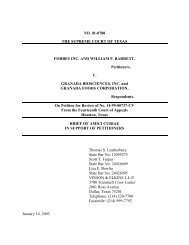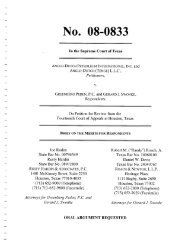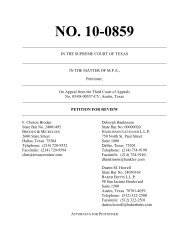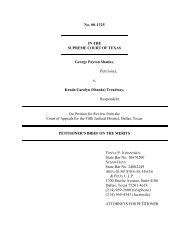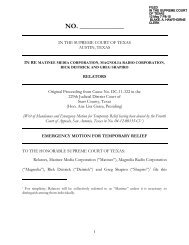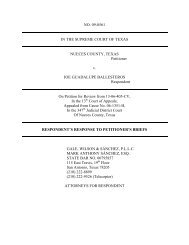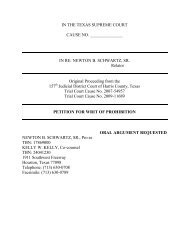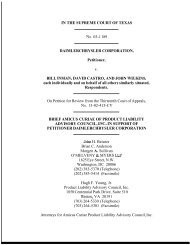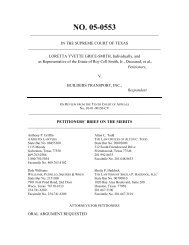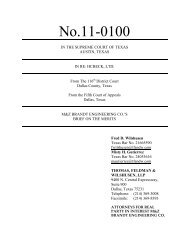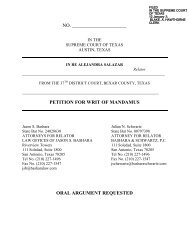Petition for Writ of Mandamus - Filed - Supreme Court of Texas
Petition for Writ of Mandamus - Filed - Supreme Court of Texas
Petition for Writ of Mandamus - Filed - Supreme Court of Texas
Create successful ePaper yourself
Turn your PDF publications into a flip-book with our unique Google optimized e-Paper software.
Item 13. Research credit limit<br />
Item 12 multiplied by 0.50 (50%).<br />
Item 14. Research credit available<br />
Enter the lower <strong>of</strong> Item 11 or Item 13.<br />
PART D - Temporary Credits<br />
Item 15. Temporary credit <strong>for</strong> business loss<br />
carry<strong>for</strong>wards<br />
A qualifying taxable entity must have preserved its right to<br />
take this credit on or be<strong>for</strong>e the due date <strong>of</strong> its 2008 report.<br />
Enter the result <strong>of</strong> the following calculation in Item 15:<br />
• preserved amount <strong>of</strong> business loss carry<strong>for</strong>wards (Item<br />
2 <strong>of</strong> Form 05-172 filed in 2008)<br />
• multiplied by 2.25% (0.0225)<br />
• multiplied by 4.5% (0.045)<br />
The unused carryover from a previous report should be<br />
reported in Item 22.<br />
If the taxable entity is a combined group, each qualifying<br />
member <strong>of</strong> the group should have made a separate<br />
preservation <strong>of</strong> the business loss carry<strong>for</strong>wards. Use the<br />
cumulative amount <strong>of</strong> the preserved business loss<br />
carry<strong>for</strong>wards in the calculation <strong>of</strong> the credit.<br />
Note: If a member <strong>of</strong> a combined group leaves the group, the<br />
business loss carry<strong>for</strong>ward <strong>of</strong> that member may no longer<br />
be used by the group or by the member. There is no<br />
proration <strong>for</strong> a partial year.<br />
Item 16. 1992 Temporary credit<br />
This credit is only available to corporations that preserved<br />
their right in writing to take the credit by March 2, 1992. If the<br />
credit has been taken on any previous reports or will be taken<br />
on this report, the corporation must pay the additional tax in<br />
Item 17. This credit expires <strong>for</strong> all eligible entities in 2012.<br />
The credit is computed as follows:<br />
• determine the amount, as <strong>of</strong> the end <strong>of</strong> the corporation's<br />
accounting year ending in 1991, that is the excess <strong>of</strong> the<br />
basis used <strong>for</strong> financial accounting purposes over the<br />
basis used <strong>for</strong> federal income tax purposes <strong>of</strong> qualifying<br />
assets and liabilities that at some future date will reverse<br />
(use this amount every year the credit is taken);<br />
• multiply this amount by the apportionment factor entered in<br />
Item 18 <strong>of</strong> the corporation's 1992 franchise tax report (use<br />
this apportionment factor every year the credit is taken);<br />
• multiply this amount by 5.0% (0.05) per privilege period;<br />
• multiply this amount by 4.5% (0.045)<br />
Item 17. 1992 Additional tax due<br />
If the corporation has elected to take the 1992 temporary<br />
credit on this or previous reports, then an additional tax<br />
due must be calculated by multiplying the taxable entity's<br />
taxable capital by 0.2% (0.002) or this credit will be revoked<br />
<strong>for</strong> the current and future reports.<br />
The taxable entity's taxable capital is computed by adding together<br />
the entity's stated capital and surplus as those terms are defined<br />
in franchise tax Rules 3.550 and 3.551. If taxable capital is zero<br />
or less, then no additional tax is due and the temporary credit<br />
may still be taken to reduce tax due on net taxable margin.<br />
Item 18. Total temporary credits<br />
Add Items 15 and 16, then subtract Item 17.<br />
PART E - Credits Claimed<br />
The total credits claimed cannot reduce the total tax due below<br />
zero; there<strong>for</strong>e, you may need to allocate the credits claimed<br />
in Items 19 through 21 so that the tax due will equal zero.<br />
Item 19. Investment credit claimed<br />
Cannot be greater than the amount entered on Item 6.<br />
Item 20. Jobs creation credit claimed<br />
Cannot be greater than the amount entered on Item 10.<br />
Item 21. Research credit claimed<br />
Cannot be greater than the amount entered on Item 14.<br />
Item 22. Other<br />
Carryover <strong>of</strong> 2008 temporary credit <strong>for</strong> business loss<br />
carry<strong>for</strong>wards<br />
Enter the amount <strong>of</strong> credit that exceeded the amount <strong>of</strong> tax<br />
due on the 2008 or subsequent reports that has not already<br />
been used. If the EZ computation was used on a prior report,<br />
there is no carryover amount from that year. Additionally, if<br />
the credit was not claimed on a prior year's report or the<br />
prior year's report was not filed timely, there is no carryover<br />
amount from that year.<br />
Example: A taxable entity had a business loss credit <strong>of</strong><br />
$2,000 that could be used on the 2011 franchise tax report.<br />
The entity had $1,200 tax due, so they used only $1,200 <strong>of</strong><br />
the available business loss credit, They may carryover the<br />
remaining $800 to subsequent report years. On the 2012<br />
report, this $800 should be reported in Item 22.<br />
Credit amounts reported by banks <strong>for</strong> tax erroneously paid<br />
on reports originally due prior to Jan. 1, 1992.<br />
Note: Credits <strong>for</strong> extension payments or prior payments should<br />
not be entered in this item. Enter extension payments on<br />
franchise tax Form 05-170, Item 2.<br />
Item 23. Total credits claimed<br />
Add Items 18, 19, 20, 21 and 22. Enter this amount on Item<br />
31 <strong>of</strong> the franchise tax report Form 05-158-B.<br />
Form 05-163<br />
<strong>Texas</strong> Franchise Tax No Tax Due In<strong>for</strong>mation<br />
Report<br />
Filing Requirements: A taxable entity, including a combined<br />
group, qualifies to file the No Tax Due In<strong>for</strong>mation Report<br />
when any <strong>of</strong> the four statements shown in Item 1 through<br />
Item 4 are true. Blacken the circle <strong>for</strong> each true statement.<br />
Combined report<br />
A combined group may file a No Tax Due In<strong>for</strong>mation Report.<br />
The determination <strong>of</strong> whether a combined group is eligible<br />
is based on the total revenue <strong>of</strong> the combined group as a<br />
whole after eliminations. Each member <strong>of</strong> the group must<br />
20




